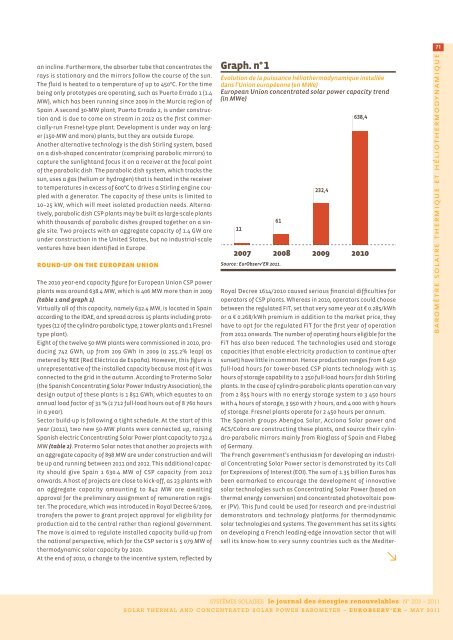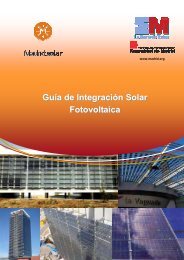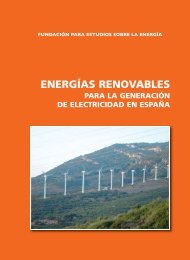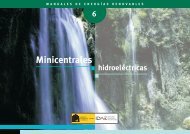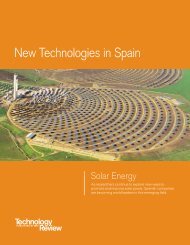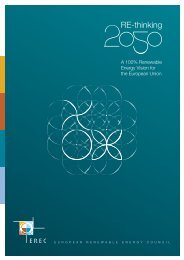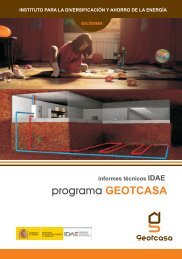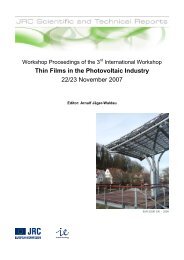BAROMÃTRE SOLAIRE THERMIQUE ET - EurObserv'ER
BAROMÃTRE SOLAIRE THERMIQUE ET - EurObserv'ER
BAROMÃTRE SOLAIRE THERMIQUE ET - EurObserv'ER
You also want an ePaper? Increase the reach of your titles
YUMPU automatically turns print PDFs into web optimized ePapers that Google loves.
71baromètre solaire thermique et héliothermodynamique<br />
an incline. Furthermore, the absorber tube that concentrates the<br />
rays is stationary and the mirrors follow the course of the sun.<br />
The fluid is heated to a temperature of up to 450°C. For the time<br />
being only prototypes are operating, such as Puerto Errado 1 (1.4<br />
MW), which has been running since 2009 in the Murcia region of<br />
Spain. A second 30-MW plant, Puerto Errado 2, is under construction<br />
and is due to come on stream in 2012 as the first commercially-run<br />
Fresnel-type plant. Development is under way on larger<br />
(150-MW and more) plants, but they are outside Europe.<br />
Another alternative technology is the dish Stirling system, based<br />
on a dish-shaped concentrator (comprising parabolic mirrors) to<br />
capture the sunlightand focus it on a receiver at the focal point<br />
of the parabolic dish. The parabolic dish system, which tracks the<br />
sun, uses a gas (helium or hydrogen) that is heated in the receiver<br />
to temperatures in excess of 600°C to drives a Stirling engine coupled<br />
with a generator. The capacity of these units is limited to<br />
10–25 kW, which will meet isolated production needs. Alternatively,<br />
parabolic dish CSP plants may be built as large-scale plants<br />
whith thousands of parabolic dishes grouped together on a single<br />
site. Two projects with an aggregate capacity of 1.4 GW are<br />
under construction in the United States, but no industrial-scale<br />
ventures have been identified in Europe.<br />
round-up on the european union<br />
The 2010 year-end capacity figure for European Union CSP power<br />
plants was around 638.4 MW, which is 406 MW more than in 2009<br />
(table 1 and graph 1).<br />
Virtually all of this capacity, namely 632.4 MW, is located in Spain<br />
according to the IDAE, and spread across 15 plants including prototypes<br />
(12 of the cylindro-parabolic type, 2 tower plants and 1 Fresnel<br />
type plant).<br />
Eight of the twelve 50-MW plants were commissioned in 2010, producing<br />
742 GWh, up from 209 GWh in 2009 (a 255.2% leap) as<br />
metered by REE (Red Eléctrica de España). However, this figure is<br />
unrepresentative of the installed capacity because most of it was<br />
connected to the grid in the autumn. According to Protermo Solar<br />
(the Spanish Concentrating Solar Power Industry Association), the<br />
design output of these plants is 1 851 GWh, which equates to an<br />
annual load factor of 31 % (2 712 full-load hours out of 8 760 hours<br />
in a year).<br />
Sector build-up is following a tight schedule. At the start of this<br />
year (2011), two new 50-MW plants were connected up, raising<br />
Spanish electric Concentrating Solar Power plant capacity to 732.4<br />
MW (table 2). Protermo Solar notes that another 20 projects with<br />
an aggregate capacity of 898 MW are under construction and will<br />
be up and running between 2011 and 2012. This additional capacity<br />
should give Spain 1 630.4 MW of CSP capacity from 2012<br />
onwards. A host of projects are close to kick-off, as 23 plants with<br />
an aggregate capacity amounting to 842 MW are awaiting<br />
approval for the preliminary assignment of remuneration register.<br />
The procedure, which was introduced in Royal Decree 6/2009,<br />
transfers the power to grant project approval for eligibility for<br />
production aid to the central rather than regional government.<br />
The move is aimed to regulate installed capacity build-up from<br />
the national perspective, which for the CSP sector is 5 079 MW of<br />
thermodynamic solar capacity by 2020.<br />
At the end of 2010, a change to the incentive system, reflected by<br />
Graph. n°1<br />
Évolution de la puissance héliothermodynamique installée<br />
dans l’Union européenne (en MWe)<br />
European Union concentrated solar power capacity trend<br />
(in MWe)<br />
11<br />
61<br />
232,4<br />
638,4<br />
2007 2008 2009 2010<br />
Source : EurObserv’ER 2011.<br />
Royal Decree 1614/2010 caused serious financial difficulties for<br />
operators of CSP plants. Whereas in 2010, operators could choose<br />
between the regulated FiT, set that very same year at € 0.285/kWh<br />
or a € 0.268/kWh premium in addition to the market price, they<br />
have to opt for the regulated FiT for the first year of operation<br />
from 2011 onwards. The number of operating hours eligible for the<br />
FiT has also been reduced. The technologies used and storage<br />
capacities (that enable electricity production to continue after<br />
sunset) have little in common. Hence production ranges from 6 450<br />
full-load hours for tower-based CSP plants technology with 15<br />
hours of storage capability to 2 350 full-load hours for dish Stirling<br />
plants. In the case of cylindro-parabolic plants operation can vary<br />
from 2 855 hours with no energy storage system to 3 450 hours<br />
with 4 hours of storage, 3 950 with 7 hours, and 4 000 with 9 hours<br />
of storage. Fresnel plants operate for 2 450 hours per annum.<br />
The Spanish groups Abengoa Solar, Acciona Solar power and<br />
ACS/Cobra are constructing these plants, and source their cylindro-parabolic<br />
mirrors mainly from Rioglass of Spain and Flabeg<br />
of Germany.<br />
The French government’s enthusiasm for developing an industrial<br />
Concentrating Solar Power sector is demonstrated by its Call<br />
for Expressions of Interest (EOI). The sum of 1.35 billion Euros has<br />
been earmarked to encourage the development of innovative<br />
solar technologies such as Concentrating Solar Power (based on<br />
thermal energy conversion) and concentrated photovoltaic power<br />
(PV). This fund could be used for research and pre-industrial<br />
demonstrators and technology platforms for thermodynamic<br />
solar technologies and systems. The government has set its sights<br />
on developing a French leading-edge innovation sector that will<br />
sell its know-how to very sunny countries such as the Mediter-<br />
SYSTÈMES <strong>SOLAIRE</strong>S le journal des énergies renouvelables N° 203 – 2011<br />
SOLAR THERMAL AND CONCENTRATED SOLAR POWER BAROM<strong>ET</strong>ER – EUROBSERV’ER – MAY 2011


